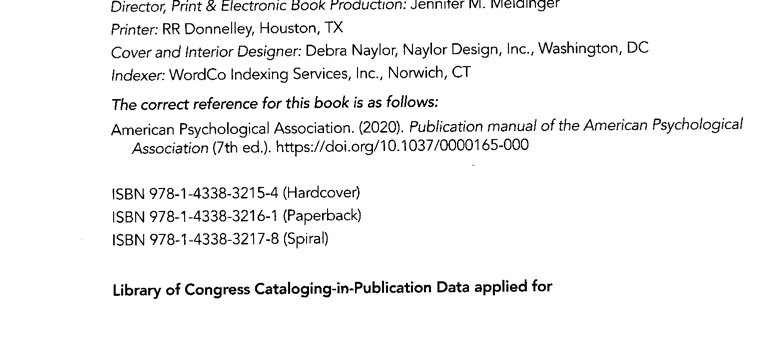In a recent post, APA7 – not so sure…, I said that one of the things I like about the latest edition of the APA Publication Manual is that it standardises the recording of a DOI – to the form: https//doi.org/10.xxxxx.yyyy. Previously there were several different ways of recording a DOI, including
doi:10.1098/rstb.2010.0321
http://dx.doi.org/10.1098/rstb.2010.0321
https://doi.org/10.1098/rstb.2010.0321
All three methods were accepted in APA style documents, with the caveat that the formats should not be mixed in any one reference list, authors should change the format of any DOIs if and as necessary to provide a consistent style in that paper.
The latest edition of APA advises a standard format, so this item would now be referenced only as https://doi.org/10.1098/rstb.2010.0321.
This standardisation is good, it reduces potential confusion.
But it’s not just online documents which have DOIs – print documents are often assigned DOIs as well. The APA-style reference for APA’s Publication manual is (according to my paperback edition of the style guide, p. iv):

American Psychological Association (2020). Publication manual of the American Psychological Association (7th ed.). https://doi.org/10.1037/0000165-000
Which may make for complications (especially for students in IB schools).
In an earlier post, Just a matter of time, I pointed to confusion between online material and material obtained online. Students (and teachers and others) are often confused in this regard; the title of Katie Greer and Shawn McCann’s article says it all: Everything Online is a Website: Information Format Confusion in Student Citation Behaviors.
IB adds to the confusion by requiring students to provide dates of access for electronic sources.
Now APA7 adds to the pot by requiring that DOIs be provided, using the https:// format, for print materials as well as for online materials:
Include a DOI for all works that have a DOI, regardless of whether you used the online version or the print version (APA7, p. 299).
Putting it all together, I’ve got a little list – of incompatible requirements. *
- Many referencing style guides (including APA) advise that date of access is needed only for online materials which are unstable, their contents or the URL might change or be changed.
- The guides advise that materials with a DOI are regarded as stable so do not need a date of access.
- APA7 requires that if a source has a DOI then it should be included in the reference.
- APA7 requires that the DOI use the https:// protocol, thus
https://doi.org/10.1037/0000165-000. - (As noted,) materials with a DOI are regarded as stable so do not need a date of access (in major referencing guides).
- IB requires that references for electronic sources include the date of access.
- IB examiners have been known to comment “Date of access?” on reference lists which include DOIs which do not have dates of access – marks may have been deducted for the omission.
- It is unlikely that IB examiners will check whether a work in a reference list which carries a DOI is available in print; the DOI will have the https:// protocol and therefore look just like an online source.
- IB examiners might therefore deduct marks for not including the date of access of a print work because they think it is an online source and therefore should have a date of access.
It’s a fine how-de-do, isn’t it, a pretty mess AND a state of things? *
Here are two suggestions for resolving the conundrum:
1) if referencing print materials with DOI for IB assessments, advise students not to give the DOI despite any advice to the contrary in the referencing guide.
OR
2) IB should instruct examiners that if a reference includes a DOI – including entries in the form https://doi.org/10.xxxxx.yyyy – then no date of access is required; to dispel confusion in schools, this advice could (and should) be added to IB guidance such as the page Acknowledging the ideas or work of another person—minimum requirements.
* I seem to have Gilbert and Sullivan’s Mikado playing earworm, both “I’ve got a little list” and “Here’s a how-de-do” feature in the comic opera – which leads to the thought, if we are trying to “make the punishment fit the crime,” we must first be sure that a crime has been committed.

